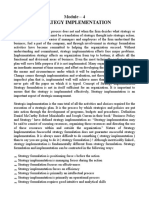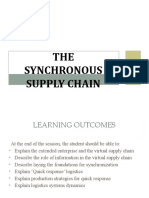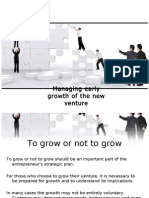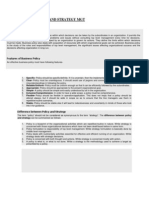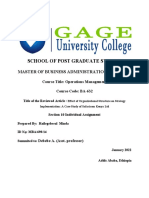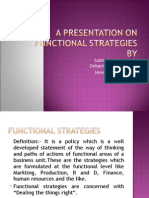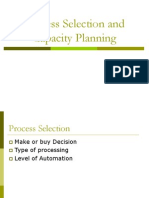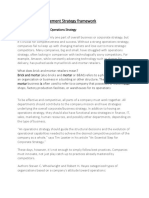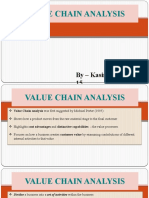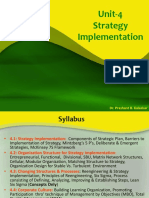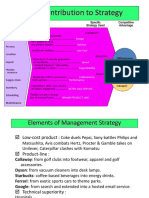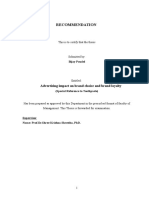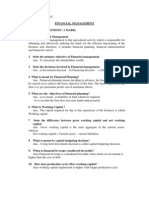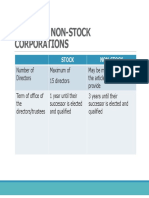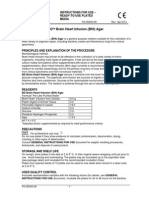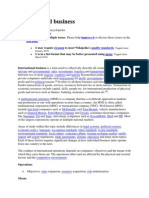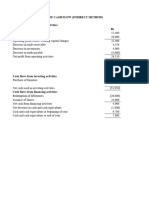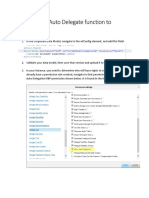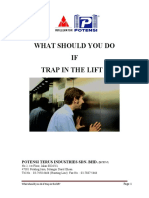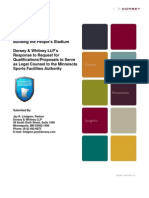Unit-5: Strategy Implementation
and Control
STRATEGIC
MANAGEMENT
MBA IV Semester
Core Course
Course Instructor : B. G. Bhattacharya
Bharathiar University, Coimbatore,
India
Institute of Banking & Mgmt. Studies
Chakupat, Lalitpur
Ch 5 - 1
�The vision must
be followed by
the venture. It is
not enough to
stare up the steps
we must step
up the stairs.
Vance Havner
Course Instructor : B. G. Bhattacharya
Ch 5 - 2
�What is Strategy Implementation
Implementation is the final step in the strategic
management process and it is how strategy put
into action.
Some people argue that strategy implementation
is the most difficult and important part of
strategic management.
Course Instructor : B. G. Bhattacharya
Ch 5 - 3
�What is Strategy Implementation
Strategic Implementation is a process of activating the
strategy. It is the sum total of all the activities and
choices required for execution of a strategic plan.
It is the process by which strategies & policies are put
into action through the development of programs,
budgets and procedures.
Strategy implementation may be said to consist of
securing resources, organizing these resources and
directing the use of these resources within and outside
the organization.
Course Instructor : B. G. Bhattacharya
Ch 5 - 4
�Implementation Process Questions
Who are the people to carry out the strategic plan?
What must be done to align operations with new
direction?
How is work going to be coordinated?
Course Instructor : B. G. Bhattacharya
Ch 5 - 5
�Allocating Resources
Building a
Capable
Organization
Exercising
Strategic
Leadership
Establishing StrategySupportive Policies
Strategy
Implementers
Action Agenda
Shaping Corporate
Culture to Fit Strategy
Tying Rewards
to Achievement
of Key Strategic Targets
Course Instructor : B. G. Bhattacharya
Instituting Best
Practices for
Continuous
Improvement
Installing
Support
Systems
Ch 5 - 6
�Process of Strategy Implementation
Structure
Task-Focus
(Value)
Firm
Strategy
People
Course Instructor : B. G. Bhattacharya
Decision
Processes
and
Controls
Firm
Performance
Reward
Systems
Ch 5 - 7
�Process of Strategy Implementation
Task-Focus
(Value)
Structure
Uncertainty
Diversity
Interdependence
Reward
Systems
Decision
Processes
and
Controls
Division of labor
Departmentalization
Shape
Distribution of power
Performance
measures
Compensation
Promotion
Job design
Course Instructor : B. G. Bhattacharya
People
Planning and control systems
Integration roles
Information systems
Decision making procedures
Recruiting and selection
Leader style
Transfer and promotion
Training and development
Ch 5 - 8
� More time than planned
Unanticipated problems
Activities ineffectively coordinated
Crises deferred attention away
Problems in
Implementing
Strategic plans
Employees w/o capabilities
Inadequate employee training
Uncontrollable external factors
Inadequate leadership
Poorly defined tasks
Inadequate information systems
Course Instructor : B. G. Bhattacharya
Ch 6 - 9
�Functional Strategies
Definition
Functional strategies (or operational strategies) are
the short-term goal-directed decisions and actions of
the organizations various functional areas.
Different from:
Business strategy
How do we win?
Corporate Strategy
What do we do?
Course Instructor : B. G. Bhattacharya
Ch 5 - 10
�Functional Strategies
Different Functions
Production operations
Marketing
Human Resources
Research and Development
Information Systems
Financial
Course Instructor : B. G. Bhattacharya
Ch 5 - 11
�Functional Strategies
Production & Operations
Current strategies
Just in time
Inventory management
Materials replacement
Project management
Course Instructor : B. G. Bhattacharya
Ch 5 - 12
�Functional Strategies
Production & Operations
Production process
Capacity
Location
Work design
Lay-out
Course Instructor : B. G. Bhattacharya
Ch 5 - 13
�Functional Strategies
Marketing
Types of strategies
Segmentation
Target market
Differentiation
4 Ps
Product, price, promotion, place (channel)
Current strategies
Relationship marketing
Database marketing
Course Instructor : B. G. Bhattacharya
Ch 5 - 14
�Functional Strategies
HR strategy
High Performance Work Team
Self-directed
Job rotation
Problem solving
Contingent pay
Work flow
Staffing
Course Instructor : B. G. Bhattacharya
Ch 5 - 15
�Functional Strategies
HR strategy
Employee separation (retrenchment)
Performance appraisal
Training and development
Compensation
Employee and labor relations
Current strategies
People first
High Tech resource
Course Instructor : B. G. Bhattacharya
Ch 5 - 16
�Functional Strategies
R&D and IS
R&D
R&D emphasis
R&D timing
Product and development
IS
Technology
Types of systems
Course Instructor : B. G. Bhattacharya
Ch 5 - 17
�Functional Strategies
Financial
Evaluation
Forecasting, planning, budgeting
Financial mix
Other decisions
Capital budget
Stock dividend
Cash flow
Working capital
Loans or leases
Course Instructor : B. G. Bhattacharya
Ch 5 - 18
�Functional Strategies
Implementation and Evaluation
Action! Processes, Activities, Budgets,
Structure and Culture
Each function is specific in scope but broad in
focus
Specific performance evaluation
Qualitative
Quantitative
Benchmarking
Course Instructor : B. G. Bhattacharya
Ch 5 - 19
�Organizational Structures for
Strategy Implementation
An organizational structure consists of activities such as task
allocation, coordination and supervision, which are directed towards the
achievement of organizational aims. It can also be considered as the
viewing glass or perspective through which individuals see their
organization and its environment.
An organization can be structured in many different ways, depending on
their objectives. The structure of an organization will determine the
modes in which it operates and performs.
Organizational structure affects organizational action in two big ways.
First, it provides the foundation on which standard operating procedures
and routines rest. Second, it determines which individuals get to
participate in which decision-making processes, and thus to what extent
their views shape the organizations actions.
Course Instructor : B. G. Bhattacharya
Ch 5 - 20
�Organizational Structures for
Strategy Implementation
All organizations require some form of organizational
structure to implement and manage their strategies
Firms frequently alter their structure as they grow in size and
complexity
Three basic structure types:
Simple Structure
Functional Structure
Multi-divisional Structure (M-form)
Course Instructor : B. G. Bhattacharya
Ch 5 - 21
�Some Structural Definitions
The Simple Structure is a structure in which the owner-manager
makes all major decisions and monitors all activities while the staff
serves as an extension of the managers supervisory authority.
The Functional Structure is a structure consisting of a Chief
Executive Officer and a limited corporate staff, with functional line
managers in dominant organizational areas, such as production,
accounting, marketing, R&D, engineering, and human resources.
The Multi Dimensional (M-form) structure consists of operating
divisions, each representing a separate business or profit center in
which the top corporate officer delegates responsibilities for day-today operations and business unit strategy to division managers.
Course Instructor : B. G. Bhattacharya
Ch 5 - 22
�Some Structural Definitions
The Cooperative form is a structure in which horizontal integration
is used to bring about interdivisional cooperation.
The Strategic Business Unit form is a structure consisting of
three levels: corporate head quarters, strategic business units
(SBUs), and SBU divisions.
The Competitive form is a structure in which there is complete
independence among the firms divisions.
The World Wide Geographic Area Structure is a structure
emphasizing national interests and facilitating the firms efforts to
satisfy the local or cultural differences.
Course Instructor : B. G. Bhattacharya
Ch 5 - 23
�Some Structural Definitions
World Wide Product Divisional Structure is a structure in which
decision making authority is centralized in the world wide division
head quarters to coordinate and integrate decisions and actions
among divisional business units.
Matrix Structure is a type of structure that groups employees by both
function and product. It uses groups of employees for the
accumulation of strengths and to make up for the weaknesses.
Network structure is an example of a non-structure because it
virtually eliminates in-house business functions and replaces them
with long-term contracts with suppliers and distributors. It becomes
most useful when the firms environment is unstable and is expected
to remain so. It gives a company the increased flexibility.
Course Instructor : B. G. Bhattacharya
Ch 5 - 24
�Some Structural Definitions
Team is of the newest organizational structures developed in the 20th
century. In small businesses, the team structure can define the entire
organization. Teams can be both horizontal and vertical. While an
organization is constituted as a set of people who synergize individual
competencies to achieve newer dimensions, the quality of
organizational structure revolves around the competencies of teams in
totality.
Virtual form is a special type of structure which is a boundary less
organization. The virtual organization as not physically existing as such,
but enabled by software to exist. The virtual organization exists within a
network of alliances, using the Internet. This means while the core of
the organization can be small but still the company can operate globally
be a market leader in its niche. Because of the unlimited shelf space of
the Web, the cost of reaching niche goods is falling dramatically.
Course Instructor : B. G. Bhattacharya
Ch 5 - 25
�Organizational Structures for
Strategy Implementation
Organization Structures
Simple Structure
President
Employees
Course Instructor : B. G. Bhattacharya
Owner-manager makes decisions.
Little specialization of tasks.
Few rules, little formalization.
Advantages:
- Provides high flexibility
- Rapid product introduction
- Few coordination problems
Ch 5 - 26
�Organizational Structures for
Strategy Implementation
Organization structure
Functional structure
President
Legal
Affairs
Accounting
HRM
Finance
Course Instructor : B. G. Bhattacharya
Marketing
R&D
Production
Ch 5 - 27
�Organizational Structures for
Strategy Implementation
Organization structure
Functional structure
Advantages
- Centralized control of operations
- Promotes in-depth functional expertise
- Enhances operating efficiency where tasks are routine
Disadvantages
-
Functional coordination problems
Inter-functional rivalry
Overspecialization and narrow viewpoints
Hinders development of cross-functional experience
Slower to respond in turbulent environments
Course Instructor : B. G. Bhattacharya
Ch 5 - 28
�Multi-Divisional Structure
Each division is operated as a separate business
Appropriate for related-diversified businesses
Key task of corporate managers is exploiting synergies
among divisions
Managers use a combination of strategic controls and
financial controls
Managers try to strike a balance between:
Competing among divisions for scarce capital resources
Creating opportunities for cooperation to develop synergies
The goal is to maximize overall firm performance
Course Instructor : B. G. Bhattacharya
Ch 5 - 29
�Multi-Divisional Structure
The decision-making of managers in a MultiDivisional structure may be:
Centralized or Decentralized
Bureaucratic or Non-bureaucratic
Balance on these dimensions may change over time
Structure will evolve over time with:
Changes in strategy
Degree of diversification
Geographic scope
Nature of competition
Course Instructor : B. G. Bhattacharya
Ch 5 - 30
�Chief Executive Officer
Corporate
R&D
Division
Finance
Corporate
Finance
Strategic
Planning
Division
Production Engineering
Course Instructor : B. G. Bhattacharya
Corporate
Marketing
Multi-Divisional
Structure
Corporate
Human
Resources
Division
Accounting
Sales &
Marketing
Division
Human
Resources
Ch 5 - 31
�Variations of the
Multi-Divisional Structure
Multi-Divisional
Structure
(M-form)
Cooperative
Form
Related-Constrained
Strategy
Course Instructor : B. G. Bhattacharya
Strategic Business Unit
(SBU) Structure
Related-Linked
Strategy
Competitive
Form
Unrelated /Holding
Company Strategy
Ch 5 - 32
�Cooperative Form
(Related-Constrained Strategy)
President
Government
Affairs
Legal
Affairs
Corporate
R&D Lab
Strategic
Planning
Corporate
Human
Resources
Corporate
Marketing
Product
Division
Product
Division
Product
Division
Product
Division
Corporate
Finance
Product
Division
Structural integration devices create tight links among all divisions
Large corporate office with R&D likely to be centralized
Culture emphasizes cooperative sharing
Course Instructor : B. G. Bhattacharya
Ch 5 - 33
�SBU Form
(Related-Linked Strategy)
President
Corporate
R&D
Strategic
Business Unit
A
Corporate
Finance
Strategic
Planning
Strategic
Business Unit
B
Division
Division
Division
Corporate
Marketing
Strategic
Business Unit
C
Division
Corporate
Human
Resources
Strategic
Business Unit
D
Division
Division
Structural integration exists among divisions within SBUs, but not across SBUs
Each SBU may have its own budget for staff to foster integration
Corporate headquarters staff serve as consultants to SBUs and divisions
Course Instructor : B. G. Bhattacharya
Ch 5 - 34
�Competitive Form
(Unrelated /Holding Company Strategy)
President
Legal
Affairs
Division
Finance
Division
Division
Auditing
Division
Division
Corporate headquarters has a small staff
Finance and auditing are the most prominent functions in the headquarters
Divisions are independent and separate for financial evolution purposes
Divisions retain strategic control, but cash is managed by the corporate office
Divisions compete for corporate resources
Course Instructor : B. G. Bhattacharya
Ch 5 - 35
�Implementation of a Multidomestic Strategy
Worldwide
Geographic
Area
Structure
United
States
Asia
Multinational
Headquarters
Latin
America
Australia
Europe
Middle
East/
Africa
Green circles indicate decentralization of operations
Emphasis is on differentiation by local demand to fit a culture
Corporate headquarters coordinates financial resources among
independent subsidiaries
The organization is like a decentralized federation
Course Instructor : B. G. Bhattacharya
Ch 5 - 36
�Implementation of a Global Strategy
Worldwide
Product
Divisional
Structure
Worldwide
Products
Division
Worldwide
Products
Division
Worldwide
Products
Division
Worldwide
Products
Division
Multinational
Headquarters
Worldwide
Products
Division
Worldwide
Products
Division
Green circle indicates centralization to coordinate information
flow among worldwide products
Headquarters uses many inter-coordination devices to facilitate
global economies of scale and scope
Headquarters also allocates financial resources cooperatively
The organization is like a centralized federation
Course Instructor : B. G. Bhattacharya
Ch 5 - 37
�Matrix Structure
Top Management
Manufacturing
Sales
Finance
Personnel
Manager:
Project
A
Manufacturing
Unit
Sales
Unit
Finance
Unit
Personnel
Unit
Manager:
Project
B
Manufacturing
Unit
Sales
Unit
Finance
Unit
Personnel
Unit
Manager:
Project
C
Manufacturing
Unit
Sales
Unit
Finance
Unit
Personnel
Unit
Manager:
Project
D
Manufacturing
Unit
Sales
Unit
Finance
Unit
Personnel
Unit
Course Instructor : B. G. Bhattacharya
Ch 5 - 38
�Matrix Structure
Matrix structure
Contains aspects of both functional and product-divisional
structures.
Advantages:
- Creates checks and balances between competing viewpoints
- Promotes holistic view of the firm
- Encourages cooperation and consensus building
Disadvantages:
- Very complex and costly
- Shared authority increases communication time
- Difficult to respond rapidly
- May promote bureaucracy and reduce innovation (in large firms)
Course Instructor : B. G. Bhattacharya
Ch 5 - 39
�Network Structure
Packagers
Designers
Suppliers
Corporate
Headquarters
(Broker)
Manufacturers
Distributors
Promotion/
Advertising
Agencies
Course Instructor : B. G. Bhattacharya
Ch 5 - 40
�Strategic Networks
A Strategic Network is a grouping of organizations
that has been formed to create value through
participation in an array of cooperative arrangements,
such as a strategic alliance
A Strategic Center Firm often manages the network
The Strategic Center Firm identifies actions that
increase the opportunity for each firm to achieve
success through its participation in the network
The Strategic Center Firm creates incentives that
reduce the probability of any single firm taking
advantage of its network partners
Course Instructor : B. G. Bhattacharya
Ch 5 - 41
�A Strategic Network
Network Firms
Course Instructor : B. G. Bhattacharya
Strategic
Center
Firm
Ch 5 - 42
�Strategic Outsourcing
Strategic
Center
Firm
Center firm coordinates outsourcing among partners,
initiates actions and coordinates problem solving
Course Instructor : B. G. Bhattacharya
Ch 5 - 43
�Capability and Technology
Strategic
Center
Firm
Center firm attempts to develop each partners core competencies and
provides incentives for network firms to share their capabilities and
competencies with partners
Strategic center firm manages the development and sharing technologybased ideas among network partners
Course Instructor : B. G. Bhattacharya
Ch 5 - 44
�Building Linkages to Facilitate Learning
Strategic
Center
Firm
Strategic center firm emphasizes to partners the need to build linkages between
value chains and networks of value chains.
The strategic network seeks to develop a competitive advantage in primary or
support activities
Course Instructor : B. G. Bhattacharya
Ch 5 - 45
�The 7-S Model
Course Instructor : B. G. Bhattacharya
Ch 5 - 46
�The 7-S Model
The 7S model, developed by Mckinsey Consulting, can
describe how effectively one can organize a company,
holistically.
It is based around seven key elements of any organization,
with the view that in order for it to operate successfully, all the
elements in this model must align synergistically together.
The factors are split into two groups: hard or soft. The hard
elements are those that can physically be seen when in place,
whereas the soft are more intangible and cannot readily be
seen.
Course Instructor : B. G. Bhattacharya
Ch 5 - 47
�The 7-S Model
Course Instructor : B. G. Bhattacharya
Ch 5 - 48
�The 7-S Model
Structure: The line of reporting, task allocation, coordination and
supervision levels
Strategy: The top level plan top create competitive advantage
Systems: The supporting systems and process of the firm, like
Information systems, financial reporting, payment systems, resource
allocation etc
Shared Values: These are the core values of the company and form the
underpinning culture and how the business behaves and is perceived to
behave in the wider context of the community
Style: the overarching style of leadership adopted within the organization
Staff: the number and types of employees within the organization
Skills: the skills and competencies of the employees
Course Instructor : B. G. Bhattacharya
Ch 5 - 49
�The 7-S Model in Practice
To help with successful organizational change, the 7S Model is a good tool
to use, especially in the following sequence:
1. Understand the current state Where are we now? What is our
current strategy? How are we performing? Etc.
2. Understand the Future State Where do you want to go? What is the
strategy? How competitive will you be?
3. Create a 7S Model review on the current state Understand all the
current elements with the organization at present.
4. Create a 7S Model review on the future state What would the
seven elements look like if they were all in tandem to suit the new
direction?
5. Compare the future Framework with the current state and create a
plan to address the actions to fill the gaps in each of the 7 elements.
Course Instructor : B. G. Bhattacharya
Ch 5 - 50
�Strategic
Control
Course Instructor : B. G. Bhattacharya
Ch 5 - 51
�Definition of Strategic Control
Strategic control can be defined as process of
monitoring as to whether to various strategies adopted
by the organization are helping its internal environment
to be matched with the external environment. Strategic
control processes allow managers to evaluate a
company's program from a critical long-term
perspective. This involves a detailed and objective
analysis of a company's organization and its ability to
maximize its strengths and market opportunities.
Course Instructor : B. G. Bhattacharya
Ch 5 - 52
�Types of Strategic Control
There are four types of strategic control as follows:
1. Premise control: is designed to check systematically and continuous
whether or not the premises set during the planning and
implementation process are still valid
2. Implementation control: is designed to assess whether the overall
strategy result associated with incremental steps and actions that
implement overall strategy.
3. Strategic surveillance: It is designed to monitor a broad range of
events inside and outside the company to threaten the course of
firm's strategy.
4. Special alert control: is the need to thoroughly and often rapidly
reconsider the firm's basic strategy based on a sudden unexpected
event.
Course Instructor : B. G. Bhattacharya
Ch 5 - 53
�Types of Strategic Control
Types of Organizational Controls
Depending on the stages at which control is exercised, it
may be of three types:
Control of inputs that are required in an action, known as
feed forward control;
Control at different stages of action process, known as
concurrent, real-time, or steering control; and
Post action control based on feedback from the
completed action, known as feedback control.
Course Instructor : B. G. Bhattacharya
Ch 5 - 54
�Organizational Control
Feed-forward
Control
Concurrent Control
Input
Processing
Output
Feedback Control
Course Instructor : B. G. Bhattacharya
Ch 5 - 55
�Strategic Control Methods
Integrates Quantitative & Qualitative Measures
Encourages desired organizational behavior
Uses Financial and Non-financial information
Customer (External) focus
Rewards based upon relative contributions to organization
success
Implementing
Planning
Control Cycle
Adjusting
Course Instructor : B. G. Bhattacharya
Measuring
Ch 5 - 56
�What is Strategic Evaluation?
Glueck and Jauch have defined strategic
evaluation as follows:
Evaluation of strategy is that phase of the
strategic management process in which the top
managers determine whether their strategic
choice as implemented is meeting the objectives
of the enterprise.
Course Instructor : B. G. Bhattacharya
Ch 5 - 57
�Evaluation & Control Process
This process ensures that the company achieves
what it was set out to achieve. It compares actual
with desired performance and provides feedback
necessary for management to evaluate results and
take corrective action where necessary.
This process can be viewed in five steps:
Course Instructor : B. G. Bhattacharya
Ch 5 - 58
�Evaluation & Control Process
Objectives and
targets
Standard of
performance
Actual
performance
Comparing for
any deviations
Rectify by taking
corrective action
Course Instructor : B. G. Bhattacharya
Ch 5 - 59
�Strategic Control Systems
Should motivate people toward desired organizational
behavior rather than promote dysfunctional behavior.
Traditional
What is
Measured?
1990s thru 21st
Century
Meeting Budget
Customer Satisfaction
Production Efficiency
New Product
Development Rates
Inputs
Quantitative
Performance(Mostly
Financial)
Course Instructor : B. G. Bhattacharya
Outcomes
Quantitative & Qualitative
Performance
Ch 5 - 60
�Strategic Control Systems
Who is evaluated?
Traditional
1990s thru 21st
Century
Individuals
Individuals
Functions
Teams (Groups)
Responsibility Centers
Cross-Functional People
Course Instructor : B. G. Bhattacharya
Ch 5 - 61
�Strategic Control Systems
Basis of Rewards Control Systems
Traditional
1990s thru 21st
Century
Efficiency
Quality
Profits
Innovation
ROI
Creativity
Overall Company
Performance
Course Instructor : B. G. Bhattacharya
Ch 5 - 62
�Strategic Control Systems
Focus of Contemporary Control Systems
Traditional
Internal
1990s thru 21st
Century
Macro Environment
Industry Environment
Internal
Course Instructor : B. G. Bhattacharya
Ch 5 - 63
�Strategic
Evaluation
And
Control
Mechanism
Course Instructor : B. G. Bhattacharya
Ch 5 - 64
�Du Ponts Control Model
What you might know about DuPont
l
Worldwide benchmark for industrial SHE
$24 Billion in revenue
79,000 employees operating in 70
countries on 6 continents
5 core business segments including
DuPont Safety & Protection
Course Instructor : B. G. Bhattacharya
Ch 5 - 65
�Du Ponts Control Model
The Du Pont Planning and Control Model
The Du Pont Company developed an approach to planning
and control which was designed to monitor divisional
performance.
Its system of financial analysis brings together the activity
ratios, which measure how effectively a firm or its strategic
business units (SBUs) employ the resources they control, with
the profit margin on sales.
It also shows how these ratios interact and determine the
assets profitability.
Course Instructor : B. G. Bhattacharya
Ch 5 - 66
�Du Ponts Control Model
The (DuPont) Strategic Profit Model
Margin
management
Profit
Sales
Revenue
Profit
Net assets
Net assets
Equity
Profit
Equity
Return to
Shareholders
Sales
Revenue
Net assets
Asset
management
RONA
Return
on net
assets
Course Instructor : B. G. Bhattacharya
Gearing investment
and financial
management
ROE
Return
on
Equity
Ch 5 - 67
�Du Ponts Control Model
The Strategic Profit Model (previous slide) lets us relate management
activity components quantitatively, and helps with managerial decisions
in four ways:
Identifies the principal objective of the business ie. To maximize
shareholder return.
Identifies the growth and profit paths available to a business (improve
margins earned, increase asset productivity, increase gearing).
Highlights principal areas of decision making, ie., Asset management,
margin management and financial management.
Provides a useful model for appraising the marketing and financial
aspects of strategy options.
Course Instructor : B. G. Bhattacharya
Ch 5 - 68
�Du Pont Core Values
Ethics
Respect
to employees
and
customers
Course Instructor : B. G. Bhattacharya
Safety,
Health &
Environment
(SHE)
Ch 5 - 69
�The DuPont Approach to Managing
Process Safety
Four Key Steps:
1. Establishing a Safety Culture
2. Providing Management Leadership and Commitment
3. Implementing a comprehensive PS&RM Program
4. Achieving Operating Excellence through Operational
Discipline
PS&RM = Process Safety & Risk Management
Course Instructor : B. G. Bhattacharya
Ch 5 - 70
�Measuring
Performance
Performance measurement
improves communications internally
among employees, as well as
externally between the organization
and as customers and
stakeholders.
Course Instructor : B. G. Bhattacharya
Ch 5 - 71
�Performance Measurement
Strategic performance measures monitor the implementation and
effectiveness of an organization's strategies, determine the gap between
actual and targeted performance and determine organization
effectiveness and operational efficiency.
Good Performance Measures:
Provide a way to see if our strategy is working
Focus employees' attention on what matters most to success
Allow measurement of accomplishments, not just of the work that is
performed
Provide a common language for communication
Are explicitly defined in terms of owner, unit of measure, collection
frequency, data quality, expected value(targets), and thresholds
Are valid, to ensure measurement of the right things
Are verifiable, to ensure data collection accuracy
Course Instructor : B. G. Bhattacharya
Ch 5 - 72
�The basic Performance Pyramid
What are we in business for?
Mission
Where are we going?
Vision
What do we want to achieve?
Goals/Objectives
Strategies
Success Drivers
Performance Measures
Course Instructor : B. G. Bhattacharya
How will you achieve your
goals/objectives?
What do you need to do
well?
How will you
measure
how well you
are doing?
Ch 5 - 73
�The Balanced Scorecard is a strategic
planning and management system that
is used extensively in business and
industry, government, and nonprofit
organizations worldwide to align
business activities to the vision and
strategy of the organization, improve
internal and external communications,
and monitor organization performance
against strategic goals. It was originated
by Drs. Robert Kaplan (Harvard
Business School) and David Norton as
a performance measurement framework
that added strategic non-financial
performance measures to traditional
financial metrics to give managers and
executives a more 'balanced' view of
organizational performance.
Course Instructor : B. G. Bhattacharya
Ch 5 - 74
�The Balanced Score Card
Course Instructor : B. G. Bhattacharya
Ch 5 - 75
�The Balanced Score Card
A Balanced Scorecard is a strategic control and evaluation system that
attempts to translate the sometimes vague, pious hopes of a company's
vision/mission statement into the practicalities of managing the business
better at every level.
A Balanced Scorecard approach generally has four perspectives:
Financial
Internal business processes
Learning & Growth (human focus, or learning and development)
Customer
Course Instructor : B. G. Bhattacharya
Ch 5 - 76
�The Balanced Score Card
The Financial Perspective
Kaplan and Norton do not disregard the traditional need for financial data. Timely
and accurate funding data will always be a priority, and managers will do whatever
necessary to provide it. There is perhaps a need to include additional financialrelated data, such as risk assessment and cost-benefit data, in this category under
modern management thought.
The Customer Perspective
Recent management philosophy has shown an increasing realization of the
importance of customer focus and customer satisfaction in any business. These are
leading indicators: if customers are not satisfied, they will eventually find other
suppliers that will meet their needs. Poor performance from this perspective is thus
a leading indicator of future decline, even though the current financial picture may
look good. In developing metrics for satisfaction, customers should be analyzed in
terms of kinds of customers and the kinds of processes for which we are providing a
product or service to those customer groups.
Course Instructor : B. G. Bhattacharya
Ch 5 - 77
�The Balanced Score Card
The Business Process Perspective
This perspective refers to internal business processes. Metrics based on this
perspective allow the managers to know how well their business is running, and
whether its products and services conform to customer requirements (the mission).
These metrics have to be carefully designed by those who know these processes
most intimately.
The Learning & Growth Perspective
This perspective includes employee training and corporate cultural attitudes related
to both individual and corporate self-improvement. In a knowledge-worker
organization, people -- the only repository of knowledge -- are the main resource. In
the current climate of rapid technological change, it is becoming necessary for
knowledge workers to be in a continuous learning mode. Kaplan and Norton
emphasize that 'learning' is more than 'training'; it also includes things like mentors
and tutors within the organization, as well as that ease of communication among
workers that allows them to readily get help on a problem when it is needed.
Course Instructor : B. G. Bhattacharya
Ch 5 - 78
�The Balanced Score Card
Balance Scorecard factors - example
Department
Areas
Finance
Return On Investment
Cash Flow
Return on Capital Employed
Financial Results (Quarterly/Yearly)
Internal Business
Processes
Number of activities per function
Duplicate activities across functions
Process alignment (is the right process in
the right department?)
Process bottlenecks
Process automation
Course Instructor : B. G. Bhattacharya
Ch 5 - 79
�The Balanced Score Card
Balance Scorecard factors - example
Department
Areas
Learning & Growth
Is there the correct level of expertise for
the job?
Employee turnover
Job satisfaction
Training/Learning opportunities
Customer
Delivery performance to customer
Quality performance for customer
Customer satisfaction rate
Customer percentage of market
Customer retention rate
Course Instructor : B. G. Bhattacharya
Ch 5 - 80
�Globalization: Michael Porters
approach
Michael Porter
Professor at Harvard Business School
and strategic counselor to numerous
heads of state
Course Instructor : B. G. Bhattacharya
Ch 5 - 81
�Globalization: Michael Porters
approach
Why are some nations able to produce certain products that are recognized as
the best in the world, and as a result, capture international market share? Or
more bluntly, why do nations win or loose in the battles for world trade?
Harvard Business Schools Michael Porter, who is the author of the two most
widely quoted books on Strategic Management and a consultant much in
demand, has said in his research in the field of globalization:
High intensity domestic competition breeds international success. The key
elements of domestic competitive conditions that must be fostered if success is
to be sustained, are
Company strategy, structure and rivalry
Factor conditions
Demand conditions
Related and supporting industries
Course Instructor : B. G. Bhattacharya
Ch 5 - 82
�Globalization: Michael Porters
approach
According to M. Porter, a company should actively seek out pressure and
challenge, not try to avoid them. Part of the task is to take advantage of the home
nation in order to create the impetus for innovation. Some of the ways of doing so
are:
Sell to most sophisticated and demanding buyers and channels.
Seek out the buyers with the most difficult needs.
Establish norms of exceeding the toughest regulatory hurdles or product
standards.
Source from the most advanced and international home-based suppliers.
Treat employees as permanent.
Establish outstanding competitors as motivators.
Course Instructor : B. G. Bhattacharya
Ch 5 - 83
�Globalization: Michael Porters
approach
Where and How to Compete?
A firms home nation shapes where and how it is likely to succeed in global
competition.
Germany is a superb environment for competing in printing equipments, but does
not offer one conductive to international success in heavily advertised consumer
packaged goods.
Italy represents a remarkable setting for innovation in fashion and furnishing, but a
poor environment for success in industries that sell to government agencies or
infrastructure providers.
Japan is a good home base for competing globally in compact models of appliances
and in appliances that are inherently compact (such as microwave ovens), but a
poor home base for competing in full sized heavy equipments (such as high voltage
generators, or refrigerators).
Course Instructor : B. G. Bhattacharya
Ch 5 - 84
�Future trends in Strategic Mgmt.
The New Economy
New Directions in Strategic Thinking
Redesigning the Organization
New Modes of Leadership
Course Instructor : B. G. Bhattacharya
Ch 5 - 85
�The Turbulent 21st Century
Collapse of
New Economy
Corporate Scandals
Enron, WorldCom, Parmalat
Jack Welchs retirement
package
Dot.com bubble bursts
TMT recession
International
competition intensifies
China as Workshop of the World
Outsourcing to LDCs
The Curse of
Terrorism
Sept. 11, 2001
Suicide bombings
in
Israel, Iraq, Saudi
Arabia, Turkey,
Afghanistan
Decline of
Multilateralism
War
Invasion of Afghanistan
& Iraq
Civil wars in Congo,
Liberia, Sudan, Somalia
Collapse of Doha round
Trade wars between US, EU, China
Weakening of UN
Age of
Disbelief
Unstable Currencies
Fear of Disease
US$ declines by >50% against
Euro 2002-04
SARS, Mad Cow, Bird
Flu
Course Instructor : B. G. Bhattacharya
Ch 5 - 86
�Forces Shaping Company Strategies
Future Sources of Profit
Limits of downsizing/cost cutting
Where are future sources of
profit?
The Business
Environment
Uncertainty
Stalling of economic
liberalization
Intense competition
Concepts & Theories
Resources & capabilities as
Technology
basis for competitive advantage Continued advances in ICT
Knowledge-based theory
of the firm
Demands of society
Option theory
Complexity theory
Social & environmental responsibility
Ethics & fairness
Quest for meaning
Course Instructor : B. G. Bhattacharya
Ch 5 - 87
�Emerging Developments
STRATEGY
Multiple competitive advantages/multiple capabilities
Innovation / New Product Development / New
Business Development
Alliances & networks
MANAGEMENT SYSTEMS
Knowledge management
(incl. best-practice transfer)
Redesigning incentive systems
Rethinking performance mgmt.
Capturing human creativity
Course Instructor : B. G. Bhattacharya
ORGANIZATION
STRUCTURE
Reconciling flexibility
& integration
Modular structures
Multidimensional structures
Informal organization &
self-organization
Ch 5 - 88
�The Need to Redesign Organizations
THE PAST
Emphasis on control
THE FUTURE
Emphasis on co-ordination
Single performance
goal
Multiple performance goals
Decisions located
centrally
Decisions located where
relevant knowledge exists
Simple structures,
unified line of command
Multidimensional
structures
Diffused authority, but
clear responsibilities
Organization by design
Self organization
Course Instructor : B. G. Bhattacharya
Ch 5 - 89
�Emerging Organizational Forms
Organizing for capability
development
Shifting emphasis of organization
design from control to coordination
From unitary to parallel
structures
Separate coordination structures for
different processes. E.g. 3Ms product
development structure; separate structures
for TQM and change management
Process-based
organizations
Organizing around business processes
Organizing around corporate processes
- entrepreneurial process
- competence building process
- renewal process
Project-based organization
E.g. engineering cos., consulting firms, also
manufacturing cos. e.g. Oticon
Network and virtual
organization
E.g. electronics in Silicon Valley, clothing
and packaging equipment in Italy
Course Instructor : B. G. Bhattacharya
Ch 5 - 90
�New Models of Leadership:
What Competencies do Top Managers Need?
THE LEADERSHIP
NEEDS
OF ORGANIZATIONS
The ability to:
build confidence
build enthusiasm
cooperate
deliver results
form networks
influence others
use information
Course Instructor : B. G. Bhattacharya
THE REQUIRED
COMPETENCIES OF
BUSINESS LEADERS
business literacy
creativity
cross-cultural
effectiveness
empathy
flexibility
proactivity
problem-solving
relation-building
teamwork
vision
Ch 5 - 91
�Thank
You
Course Instructor : B. G. Bhattacharya
Ch 5 - 92







